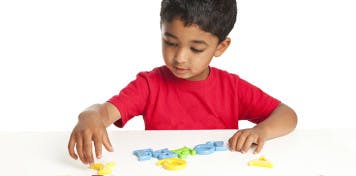


Name Writing Practice: How to Teach Your Child to Write Their Name

Learning to write your name is a huge deal for young kids. It’s usually one of the very first writing milestones they’ll achieve!
There are a few ways to make sure your child is learning to write their name properly. Name writing practice should give kids a strong sense of achievement and set them on the right path to reading and writing success. Below are some useful tips to help them reach this exciting milestone with ease, enthusiasm and confidence.
Eight tips for helping your child to practise writing their name
1. Trace over dotted lines
Before your child learns to write their name, they need to have some basic motor skills to write letters. A great way to develop this is by helping them to trace over the dotted lines that form each of the letters in their name. This will help them to hone their motor skills while learning letter formation at the same time. Check out our article with free worksheets and activities to build your preschooler's pre-writing skills.
Remember: It’s important to encourage your child to follow the one basic rule for both reading and writing: start from the top working down to the bottom, always left to right. When your child begins forming letters, either using dotted lines or working independently, always encourage them to start at the top.
2. Display their name on posters and labels
Help your child grow accustomed to seeing their name printed in their bedroom or around the house. Label their lunch containers, toy boxes and books, and hang posters on the walls which display their name printed in both capital and lowercase letters.
Try Reading Eggs for FREE today!
Reading Eggs is the multi-award winning online reading program that makes learning to read fun for children aged 2 to 13. With hundreds of guided reading lessons, fun games, lovable characters, exciting rewards and over 3000 e-books, Start your child’s reading journey with a free trial today.
3. Have fun experimenting with letter formation
Most children love a multisensory and hands-on approach to learning. Learning to form the letters in their name doesn’t always have to be done with a pencil and paper. Experiment with different materials such as clay, paints and even pieces of candy or dried fruit to form letters. Take turns writing invisible letters in the air or on each other’s backs, tracing letters in the sand with a stick, or writing letters on the bathroom mirror when it gets fogged up!
4. Grip the pencil properly
Show your child how to grip their pencil properly so that they develop good handwriting skills early on. If they start off learning to write with poor grip, they may encounter a great deal of frustration when they start school and are forced to change their habit. The ideal way to hold a pencil is with the thumb, index and middle fingers. This is sometimes known as the ‘tripod grasp’. Holding a pencil this way ensures fluid movement and allows the hand to remain stable.
Remember: Your child will be watching how you write letters and words, and how you hold a pencil. Remember to be a good model; most adults are more accustomed to typing on a keyboard nowadays, so you may need to make a special effort to hold a pencil correctly.
5. Praise early attempts at writing
Praise and encourage your child’s earliest attempts at writing by hanging up their scribbles on the wall. This will give them a great sense of pride in their abilities, and encourage them to improve!
6. Create a name puzzle
Before your child learns to write their name, they will need to be able to identify each letter and arrange them in the correct order. This can be done using fridge magnets, alphabet blocks, alphabet stamps or even using a computer or tablet. You can also create your own name puzzle by writing each letter of their name on a separate piece of paper, and getting them to arrange the letters in the right order.
7. Start practising with capital letters
Capital letters are often the first letters your child will learn. Young kids find them easier to identity, memorize and copy. Start by teaching your child how to write their name in capital letters. When they’ve mastered this, gradually introduce them to lowercase letters. Remember that most toddlers haven’t yet developed the fine motor skills they need to write lowercase letters—trying to get them to do it when they’re not ready can be discouraging.
8. Provide verbal instructions
Try to be encouraging and avoid being overly critical at your child’s attempts to write their name. Learning to write letters takes time and patience. Before they try their hand at writing, show them how it’s done while slowly explaining as you go. For example you can say, ‘I start at the top. I go down to the bottom.’ Use words to describe the formation of different parts, such as ‘big’, ‘small’, ‘straight’ and ‘curvy’. For example, if you’re writing the letter G, explain, ‘I start at the top. I make a big curve. Now I make a small line.’
Try Reading Eggs for FREE today!
Reading Eggs is the multi-award winning online reading program that makes learning to read fun for children aged 2 to 13. With hundreds of guided reading lessons, fun games, lovable characters, exciting rewards and over 3000 e-books, Start your child’s reading journey with a free trial today.






